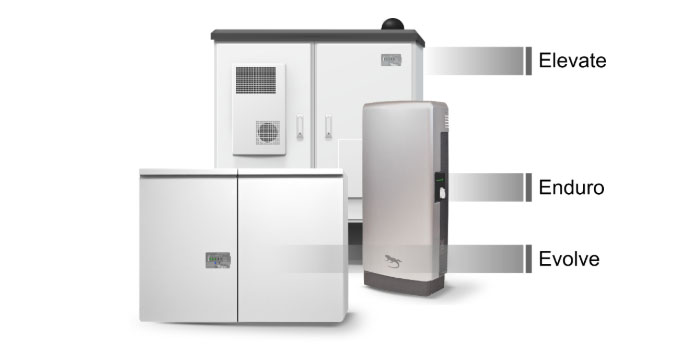The Energy Report: What are the most important new energy technologies?
James McIlree: At Dominick & Dominick, we are big believers in hydraulic fracturing, or "fracking," as it is commonly called. This technology is creating a significant new supply of natural gas and oil in the U.S. and the technology is migrating around the world, opening up market opportunities for many companies.
"The grid is very old and its reliability has been declining. As a result, companies and individuals are looking to create their own power source to guard against those times when the grid goes down."
We have a strong interest in one of those companies in particularóAcorn Energy Inc. (ACFN:NASDAQ), a holding company with a range of investments in energy technology. One of its subsidiaries is U.S. Seismic Systems, which employs a new type of fiber-optic sensor to both monitor existing oil and gas reservoirs and locate new ones. The fiber-optic product is Acorn's biggest opportunity, but Acorn also owns a firm called DSIT that does underwater sonar surveillance for high-value assets like ports and oil rigs. A third company, OmniMetrix, provides a service that remotely monitors emergency, or standby, electrical power-generator systems. Finally, GridSense has a suite of products for SmartGrid applications.
TER: Why is electrical power monitoring necessary?
JM: The quality of the electric grid in certain areas of the United States has deteriorated. The grid is very old and its reliability has been declining. Because this space is highly regulated, there has been less incentive to invest capital in the grid. As a result, companies and individuals are looking to create their own power source to guard against those times when the grid goes down, or to supplement their source of electricity. OmniMetrix can remotely monitor these private power-generation units.
TER: What kind businesses need backups to the electrical grid?
JM: Cellphone tower companies, like American Tower and Crown Castle have backup power to serve their corporate customers. If the electric grid goes down, let's say in a storm, then those cell sites go down, and AT&T and Verizon would be unable to provide cellphone service to their customers. Hospitals also have backup power, as do data storage firms.
TER: How does the monitoring work?
JM: OmniMetrix installs a device on generators that monitors the health and status of the generator. Data is collected and transmitted, typically over the cellphone network, but sometimes over satellite networks, to a network operating center, which can then alert customers if the generator is, for instance, low on fuel or in need of repair.
"The market for backup power extends beyond stand-alone generators. There are different types of backup systems."
The market for backup power extends beyond stand-alone generators. There are different types of backup systems. For example, Active Power (ACPW:NASDAQ) deploys a flywheel-based uninterruptible power supply system, or UPS system. Its system will detect even a microsecond gap in the electricity source and a flywheel that has been storing energy will fill in that gap until the electric grid comes back on. And if the grid stays off, the system commands a bank of batteries or a diesel generator to start generating power.
Some towns are looking to maintain the electricity supply for critical infrastructure via a concept dubbed a "micro grid." It's essentially a grid within a grid, an electricity generation system that kicks on in emergencies. These systems could be automated and monitored.
TER: Does OmniMetrix have competitors?
JM: There are plenty of monitoring companies as well as monitoring technologies in the market. OmniMetrix believes it has an advantage in understanding how to integrate its diagnostic tool into many different power generators and in its ability to transmit that information over the cellular network.
There are also many backup power companies in the market. Active Power's unique flywheel-based system is used for backup power. It competes against battery-backup products. Generac (GNRC:NYSE) makes stand-alone gas or diesel-fired generators that can be used for industrial applications, but these are mostly deployed for commercial and consumer use. You see those generators outside buildings everywhere. In my hometown in Connecticut, the public library has a Generac generator for backup power. When the grid goes down, the generator kicks in and the library can be used for emergency services.
TER: Is OmniMetrix completely owned by Acorn?
JM: Yes. Acorn typically owns a majority stake in the companies in its portfolio. However, it incentivizes management with ownership stakes.
TER: Is that unusual for a holding company structure?
JM: Oftentimes, managers own the holding company stock, rather than stock in the subsidiary that they manage. Acorn is a relatively unique company in that ownership is shared with the management of the subsidiary.
TER: What other companies does Acorn have in its portfolio?
JM: Besides U.S. Seismic and OmniMetrix, here are two others: One is the underwater sonar surveillance company DSIT Solutions Ltd. Another holding, GridSense, makes monitoring equipment for the electric utility industry. Its major product is called the TransformerIQ. The transformers in place on the electric grid in North America are relatively old. Transformer failure is a significant source of downtime for utilities. GridSense has created a low-cost transformer monitoring device that can alert an electric utility for a potential transformer failure. The utility can take preemptive action to replace transformers before they fail, and because of that preventative maintenance, grid uptime is increased.
TER: How does TransformerIQ detect potential failures?
JM: It monitors the voltage pattern coming in and out of the transformer. If the input/output ratio exceeds a certain band, it decides if the data indicates a chance event or a potential failure.
TER: Let's talk about how USSI is doing.
JM: The last time we spoke, "Peter," U.S. Seismic's fiber-optic sensor system, was in early trials. Many of the trials have now been turned into production orders. For the next few months, the company is conducting field trials. If these trials are successful, there should be larger production orders coming from organizations looking to deploy sensors for monitoring and exploration activities.
TER: Are the sensors primarily keyed to oil and gas fracking?
"We believe that the increase in the supply of natural gas will result in an increase in the use of natural gas in areas of the economy that haven't yet exploited the resource."
JM: Yes. And USSI is targeting the micro-seismic market segment. In a seismic shoot, a sound wave is created by a seismic event like an explosive charge, for example. The sound wave then changes depending on what kind of geologic formation it's going through. A sensor collects that sound signature. There are many different ways to create a sound wave. The hydraulic fracturing process itself generates a micro-seismic sound wave, which USSI's "geophone" equipment can capture. Once recorded, the wave can be analyzed to create a representation of the geology of an oil or gas deposit.
TER: Who's buying the USSI geophone?
JM: SR2020 Inc., a private oil and gas service company, is a customer, as is the U.S. government. The names of the other customers that have placed orders have not yet been released.
TER: Is USSI is the star of Acorn's portfolio at the moment?
JM: It's the one that we believe has the largest opportunity in front of it. Acorn's model is to buy a company, develop it and then sell it. Due to the nature of the USSI opportunity, I wouldn't be surprised if Acorn lets it grow before selling.
TER: How does a company like Acorn determine the best point to put a company on the market?
JM: In the past, Acorn has assessed the bid potential for a property and compared that metric to other uses of cash, as well as to its assessment of the remaining subsidiaries. It's a continual tradeoff between growth and sales potential, and there is no formulaic way to solve the problem.
TER: What kind of expertise does Acorn's management have to deal with these decisions?
JM: Acorn managers have been buying and selling companies for a number of years. They have developed a decentralized philosophy. They find management teams who understand the technology and the businesses that they are addressing. And then they fund them to achieve their business goals.
TER: How is fracking driving technological innovation?
JM: The increase in hydraulic fracturing has led to a significant increase in the supply of natural gas, which has led to a significant decline in prices relative to oil and coal. A lot of industries and companies are switching from gasoline-fired power to natural gas-fired power. For instance, Waste Management (WM:NYSE) is switching its fleet of garbage trucks to natural gas, as well as using the gas generated from its landfills as a fuel source. A Canadian company called Xebec (XBC:TSX) sells equipment that refines the gas coming out of the landfill and allows it to be separated into natural gas liquids that can be sold on the market and natural gas that can be used to fuel vehicles that have been converted to use natural gas as a fuel source. Westport Innovations Inc. (WPT:TSX; WPRT:NASDAQ) is a leader in the field of building engines that run on natural gas.
TER: If it is retooling its fleet, Waste Management must be assuming that natural gas is going to remain cheaper than diesel fuel for the long term.
JM: That is what a lot of investors are betting on as well. At Dominick & Dominick, we believe that the increase in the supply of natural gas will result in an increase in the use of natural gas in areas of the economy that haven't yet exploited the resource. There is a significant and probably long-lasting delta between the cost of natural gas and the cost of diesel. This creates incentives for companies to change out capital equipment in order to benefit from lower relative fuel costs.
TER: Are there any names of interest farther down the fracking services and supply chain?
JM: Clean Harbors (CLH:NYSE) is a water management business that is being driven by the requirement of water as part of the fracturing process. Heckmann Corp. (HEK:NYSE) also has a growing business in water management. It is expanding into other areas of oil and gas exploration and production, hoping to grow with the industry's expansion. A vertically integrated private company called FracTech owns trucks, compressors and even the sand that's used for frack jobs.
TER: Are fracking services companies mostly North America focused?
"Many fracking technology companies in the U.S. are positioning themselves for global expansion."
JM: Oil and gas technology frequently begins in the U.S., often in Texas or Oklahoma, and migrates into other areas of the country. Horizontal drilling and fracturing was initiated in Texas. Now, it's the major drilling technology in the Bakken field in North Dakota. It's deployed in the Marcellus shale in Pennsylvania and New York, and in the Utica shale in Ohio. And it is starting to be deployed around the world as well. There are certain countries that are dead set against fracking, like France, which just announced a ban. But China is looking to acquire the technology so it can benefit from its potentially significant reservoirs of oil and gas. Many technology companies in the United States are therefore positioning themselves for global expansion.
TER: What kind of fundamentals should an investor concentrate on when looking at fracking services opportunities?
JM: Management experience is extremely important. The balance sheet is very important. Product uniqueness, which creates a competitive advantage, is obviously very important. We also look at how a firm delivers its products to market. Does it need to create a sales force? Does it need to create partnerships? How expensive will that be? When we are looking at technology, we ask what about that technology is different?
TER: What about competitors?
JM: USSI has competitors. There are the traditional geophones made by firms, such as OYO Geospace Corp. (OYOG:NASDAQ). Its products are competitive. But USSI can offer a less expensive product that will work under harsher conditions than the competitor products. And, the USSI product is much more sensitive in capturing the sound waves than the competition. These are compelling value propositions to customers.
TER: We appreciate your time today, James.
JM: It's been a pleasure.
James McIlree has 25 years experience in the investment business, as a sell-side research analyst and buy-side analyst and portfolio manager. He focuses on emerging growth companies in the technology, telecomm, energy and defense electronics markets. Prior to joining Dominick & Dominick in October of 2011, Mr. McIlree was a managing director and research analyst at Merriman Capital covering firms at the intersection of satellite communications and defense electronics. Prior to Merriman Capital, McIlree was with Collins Stewart and its predecessor firm, C. E. Unterberg, Towbin, where he covered the defense electronics/communications sector and was director of research. McIlree holds a Bachelor of Arts in economics from the University of Chicago and a Masters in Business Administration from the University of Colorado. He is a CFA charter holder.
Want to read more exclusive Energy Report interviews like this? Sign up for our free e-newsletter, and you'll learn when new articles have been published. To see a list of recent interviews with industry analysts and commentators, visit our Exclusive Interviews page.
DISCLOSURE:
1) Peter Byrne of The Energy Report conducted this interview. He personally and/or his family own shares of the following companies mentioned in this interview: None.
2) The following companies mentioned in the interview are sponsors of The Energy Report: Acorn Energy Inc. Streetwise Reports does not accept stock in exchange for services. Interviews are edited for clarity.3) James McIlree: I personally and/or my family own shares of the following companies mentioned in this interview: None. I personally and/or my family am paid by the following companies mentioned in this interview: None. I was not paid by Streetwise Reports for participating in this interview.
The research analyst responsible for preparing this report has received compensation based upon various factors including the firm's total revenues, a portion of which is generated by investment banking activities.
Dominick & Dominick LLC expects to receive or intends to seek compensation for investment banking activities from Acorn Energy, Inc. in the next three months.
Dominick & Dominick LLC has received compensation for investment banking services from Acorn Energy, Inc. in the last 12 months.




























































